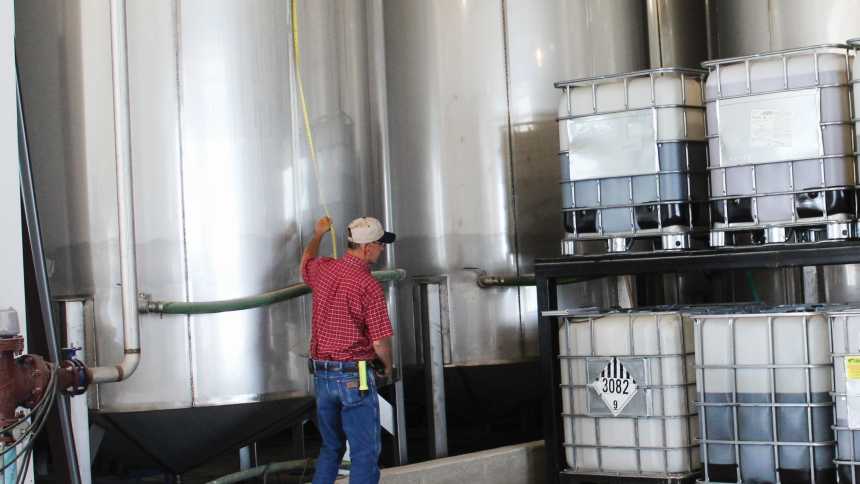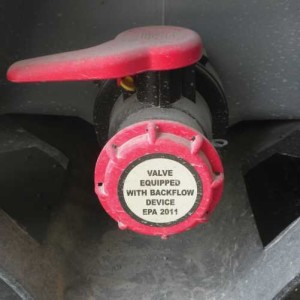Bulk Pesticide Compliance: Top 10 Areas Of Improvement For Ag Retailers

An American Agronomic Stewardship Alliance (AASA) inspector measures a bulk storage tank.
In honor of the 33-year run of David Letterman’s Late Show, the American Agronomic Stewardship Alliance (AASA) is happy to share our own Top 10 List! Ok — we admit it isn’t anything like Dave’s list but it’s interesting if crop protection stewardship rocks your world.
That’s you, right? This list includes areas that AASA inspections focus on to help bulk crop protection facilities nationwide improve their compliance with federal regulations regarding the storage, handling and repacking of bulk pesticides.
The best part about AASA’s Top 10 list is this: It used to be a Top 12 list! But thanks to the dedication of agrichemical facility managers, two of the compliance issues most frequently noted by AASA inspectors have dropped off the list because they are no longer an issue.
A Quick Review
But before we get to the Top 10 of areas for retailers to focus on, let’s review the stewardship objectives of the AASA.
AASA was incorporated in 2004 and is dedicated to educating, developing and promoting safe stewardship and best management practices for storing, handling and repackaging crop protection products throughout the distribution and supply chain. AASA is governed by a board of crop protection manufacturers, distributors, retailers and a representative from a state pesticide regulatory agency.
AASA inspectors work for the industry, not the government, and provide a friendly, face-to-face conduit of compliance information to agrichemical facilities throughout the U.S.
The relevance of AASA is significant and measurable. When new EPA regulations required containment of bulk tanks as well as management and tracking of portable refillable containers (PRCs), AASA was there to guide retailers in their compliance efforts. Working closely with EPA, AASA dissected the complex regulations into simple terms and incorporated the requirements into the AASA inspection process, assuring that every bulk product storage facility would receive direct assistance by an AASA inspector in their compliance efforts. And guess what: Overall compliance with these new EPA regulations is remarkable! Ninety-eight percent of retailers have a unique ID on the PRCs and 98% of PRCs have a one-way valve or tamper evident device. These are the two areas that have seen compliance improve so dramatically that they dropped off the Top 10 list.
Back To The AASA Top 10
Remember — in sharing this with you the goal is to educate to improve compliance with federal regulations. Based on AASA inspection results from 2012-14, we’ve listed the Top 10 areas where retailers can continue to improve to assure compliance and avoid penalties from a government inspection program. Any area where industry compliance was 95% or lower on a federal requirement made the list.
- Labeling of bulk tanks and product booklets – 88% are in compliance.
- EPA establishment number is on the bulk tank label – 83%.
- Net contents is on the bulk tank label – 80%.
- Properly anchoring or elevating tanks within containment – 72%.
- Proper containment capacity – 90%.
- Sealing drains, repairing cracks in containment, locking valves – 79%.
- Bulk containment security (tanks or the building is locked when not in use) – 89%.
- Bulk containment loading pad capacity – 89%.
- Written procedures on cleaning out tanks – 90%.
- Filled PRCs are stored on or within containment – 85%.

An intact tamper-evident device on a portable refillable container.
Before anyone gets critical, there are 100 questions on the AASA inspection checklist, so to have only 10 areas below 95% compliance is something for which the industry is to be commended. Ag retailers and distributors are busy folks and AASA’s goal is to make these complicated regulations seem second nature to them so they can continue to improve in these and all regulatory areas with regard to bulk product storage and handling.
In 2015, AASA inspections are occurring in 21 states: Illinois, Missouri, Wisconsin, Minnesota, Kentucky, Florida, Georgia, North and South Carolina, Connecticut, Delaware, Maine, Massachusetts, Maryland, New Hampshire, New Jersey, New York, Pennsylvania, Vermont, Virginia and West Virginia. AASA operates in all 50 states, working in a different region each year on a three-year inspection cycle.
AASA inspectors are required to participate in an annual two-day training course to review changes to the compliance checklist and to share situations they encounter at facilities in order to continually improve the program.
DuPont Involvement
This year, the inspectors were joined by sales representatives from DuPont: Randy Ettema and Tina Holst, who made the trip from Michigan and Wisconsin, respectively, to learn first-hand what AASA inspectors do and how they work with DuPont’s customers. Both Ettema and Holst found the meeting very worthwhile, since they are the people who follow-up with their customers when AASA finds an area of compliance that may need improvement.
“The professionalism of the inspectors stood out for me” said Ettema. “Attending the inspector training gave me a better understanding of what to look for so I can be a more knowledgeable business partner with the retailer.”
Holst echoed Ettema’s observations, saying: “I appreciated the lifetime industry involvement of several of the inspectors and their detailed analysis of bulk facility integrity and stewardship practices; to me, this demonstrated a deep passion for stewardship and for the future of agriculture.” AASA plans to enhance this opportunity for sales representatives to learn more about AASA at future training sessions.
For ag retailers, AASA is your partner in compliance, much like the new Responsible Ag (RA) program will also help you assure compliance with federal regulations pertaining to fertilizer storage and handling. Between AASA and RA, our industry has a direct avenue to education, assessment and improvement with regard to federal regulations.
Our industry cares about compliance, safety and stewardship. The agrichemical facilities that voluntarily participate are to be commended, as they help assure a safe, compliant and prosperous future for our entire industry.
For more information on AASA, visit www.aginspect.org and click on the “About AASA” tab or contact us at 309-827-2774.
Payne is president of the Illinois Fertilizer & Chemical Association, Bloomington, IL, and administrator of the AASA program.






